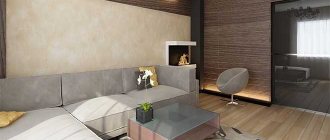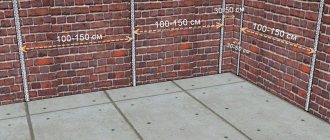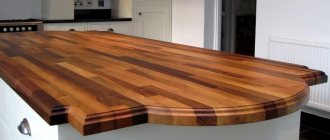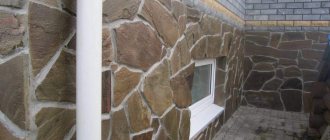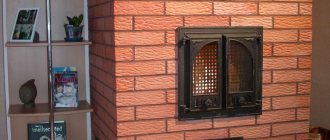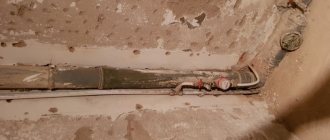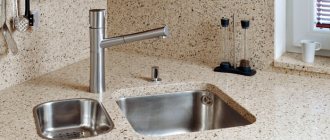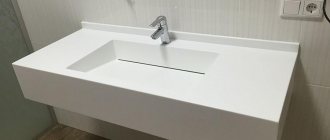When performing repair and finishing work, special attention is paid to creating interior design. Various materials and coatings are used to decorate walls. The most popular among the known options are decorative plasters.
One of the varieties of such options is decorative plaster, which creates the effect of stone on the wall. When using this material, a coating is created on the wall that imitates decorative stone. To create a stylish and unique design, you should study the features of choosing a material, as well as learn about methods of applying the composition to wall surfaces.
Composition and characteristics of stone-like plaster
Depending on the type of material, the composition of the plaster mixture may differ. However, there are basic components that should always be present in the mixture:
- A cement or gypsum composition is used as a base.
- Granular elements that include sand, quartzite, mica...
- Thickeners are added to give the mixture the desired consistency.
- Dye to give the solution a suitable shade.
In rooms, stone-like plaster is applied in a thinner layer
The use of such a composition makes it possible to impart strength, moisture resistance and increased wear resistance to the coating. Plaster with a stone effect not only gives the walls a beautiful appearance, but also creates a reliable coating.
Clearing the form
After the completed procedures, when the tiles are completely ready, you should clean the work area yourself and clean the mold. To do this, you can use a dry cloth or sponge. Carefully wipe all corners and place the mold in a dry, dark place. It is not allowed for the uniform to be in sub-zero temperatures or in the sun.
If there are white traces left in the form after the tiles, then you can pour concrete into it and leave it to harden. When the concrete pebble is removed, all the white residue is left behind. The process of removing finished gypsum tiles from the mold. Following the sequence, you can make individual gypsum tiles, which will subsequently decorate the interior of the house and create the desired atmosphere. Creating tiles is a simple process. Making a mold yourself sometimes saves money, because silicone with additives for the mold costs significantly less than the mold itself. Installing gypsum tiles on the wall will be quick and simple. The final work will delight not only the owners of the house, but also the guests. But, if there is a desire to produce a certain decorative stone, then the form is purchased on the market.
Return to contents
What are the advantages of this type of façade finishing?
Decorative stone plaster, like any other material for wall decoration, has certain advantages and disadvantages. It is worth noting that there are significantly more pros than cons.
- Good indicator of vapor permeability. Due to this, the material can “breathe”, which is very important if the cladding is carried out indoors. Decorative stone-like plaster allows you to create the most favorable indoor microclimate.
- Can withstand quite heavy loads, mechanical stress and shocks.
- It tolerates sudden changes in temperature and is not influenced by aggressive factors. Plaster of this type does not pose any threat from high humidity or low temperatures.
- For a long time it can retain its original characteristics and properties, including color and appearance.
- Has a long service life.
- The solution is easy to use.
- The finished coating is very easy to care for.
The disadvantages are that over time, corrosion may appear on the metal surface due to the water base of the plaster. You should not apply the material to insulation materials such as mineral wool, as this will negatively affect vapor permeability.
Areas of use
The possibilities for using the material are very wide. Designers offer a lot of options for finishing not only walls, ceilings, but also other surfaces with gypsum tiles. Gypsum decor is found in private homes, offices, shopping centers and other public institutions. The material decorates smooth wall panels, columns, fireplaces, niches, bay windows, and arches well. Such finishing, in the right tone, can diversify the interior design and add solidity, warmth and charm to the room.
When choosing a color spectrum, you need to remember that light shades visually expand the space, while dark shades conceal it. Decor of different shades will help to zone the room, and the thinness of the tiles will not “steal” extra centimeters from the surfaces of the walls and ceiling, and the lightness of the weight does not require the construction of a solid frame.
Finished with tiles:
- walls;
- ceiling;
- window slopes;
- fireplaces;
- spans;
- steps;
- doorways;
- columns and other surfaces.
Before you start making gypsum tiles at home, it is important to consider that the production of decorative gypsum tiles does not require sophisticated equipment, but it is better to select in advance the shape, format and shades of the material that are suitable for the room being restored.
Technology for making decorative tiles at home
Tips for using decor:
- You cannot glue the material to a base that changes shape under the influence of external factors (plywood, chipboard).
- The permissible humidity limit for the use of cladding is 75%.
- If glue gets on the outside of the tile, the lining will turn yellow.
- When laying out the material, be sure to grout the seams with extreme caution; the grout should not get on the front side, because it will be difficult to remove the grout.
The finished material is laid on the surface at a temperature from +10 to +40°C, but it is better to start the jointing process at least 24 hours after installation of the coating.
Ways to imitate a stone wall
So, let's look at what you can use to make a wall in your house or apartment like in an ancient castle. If we do not take into account the cladding made from natural prepared material, then there are several popular methods of imitation:
- From tiles. This does not mean tiles, but relief tiles made from gypsum or cement-sand mortar. Artificial stone is sold ready-to-use, already painted, and is used for interior decoration and on facades. Most often this is an imitation of torn slate, limestone (travertine), dolomite, sandstone or rock. You can make such tiles yourself by pouring the solution into rubber molds. But this is a labor-intensive process that requires special equipment (vibrating table) and painting materials for high quality.
- Stone-look panels. Plastic panels are often used for cladding the facade of a building. The advantages of this method: speed of work, practicality, attractive appearance, reasonable price. The textures are the same as those of stone made from gypsum slabs - slate, limestone, etc.
- Made from polystyrene foam. This cheap way to create artificial stone requires creativity and certain skills. The essence of the decorating process is to cut out masonry on a sheet of polystyrene foam (foam plastic, penoplex, etc.). The surface is roughened using hard brushes or other available tools. After the finished panel is glued to the wall, it is painted in a suitable color.
- Made from plaster. This is no less simple, but more practical and, perhaps, the most common type of stone finishing. Plastic mortar provides enormous opportunities for simulating any stone surface. For decoration, I will use gypsum, cement-sand (on the facade) or polymer plasters (acrylic, silicate, silicone). They may contain mineral fillers: sand, marble chips, rounded granules, etc., which help emphasize the created effect of the stone texture. Below we will look at this finishing method in detail.
How to calculate the amount of decorative stone on the walls?
If you have to buy a ready-made stone, it is important to calculate the required amount of material in advance - this will help to avoid unnecessary expenses. For any group of elements, you should add 5–10% for breakage, incorrect cutting, and other flaws in the work. Most craftsmen lay stone without leaving seams. When cladding walls, taking into account the gaps, you don’t have to make an allowance for errors.
Calculation of the amount of decorative and artificial stone for cladding an arch in a room
Order of counting elements:
- Flat parts. You should multiply the length of the wall by the width to get its area. Next, in the same way, calculate the area of all openings (windows, doors, niches, arches) and subtract them from the total, because they are not subject to cladding.
- External corner details. The range of most companies includes special elements made of decorative stone. They are used to decorate only the outer corners of windows, doors, and niches. Having measured all the lengths of the angles, they need to be added together to obtain a number in linear meters.
- Internal corner details. For arrangement you will have to cut flat stone. It is necessary to calculate the length of the internal corners in linear meters, multiply it by the overlap coefficient (0.25). The result will be the area covered by the wall with corner elements in square meters (it is already included in the main one and is calculated for reference).
Types of stone imitation
To imitate stone during interior decoration, a variety of compositions can be used: gypsum, clay, concrete, lime and others. Both mortar compositions and cheaper putty options can be used. The technique for creating a coating is divided into several types depending on how deeply the design will be worked out.
Smooth stone surface
The decorative coating on a smooth surface in the form of stone is similar to decorative plaster Travertine. Usually, to create a pattern that imitates stone, solutions with different colors are used. In this case, the prepared composition is applied to the prepared surface in several stages. Then a multi-layer coating with different patterns of stones is formed. At the final stage, the wall is processed with a grinding machine or a trowel to create an even coating.
Textured
These finishes include flat surfaces with small indentations that imitate the appearance of a rough stone surface. The textured finish may have a small decorative pattern or rather convex areas. For example, finishing such as travertine or Roman stone can be done in two ways:
- continuous, in which a uniform layer is formed, decorated after partial drying (using tingling touches of a brush, dishwashing sponge, etc.),
- partial, in which the underlying layer is made even, and the proper one is applied partially (with chaotic strokes), without completely covering the underlying layer.
Textured finishes also include decorative stone finishes that imitate facing with stone slabs or masonry with a shallow depth of grooves applied with a sharp tool.
Masonry
One of the most common design options is to create brick or stone masonry. In this case, seams are formed on the wall, resembling recesses between individual elements:
- The building mixture is applied to the wall.
- After the solution has partially dried, a seam is formed using a trowel or chisel.
- You can create a pattern in another way, for this you will need a stencil. It must be applied before applying the solution. When the mixture completely covers the wall, all that remains is to remove the stencil.
- In the final stage, it is necessary to process the coating with a sanding disc.
Flat-relief
The next deepest relief layer elaboration technique is suitable for simulating masonry made of blocks, bricks or flat stone tiles. In this case, the recesses imitating seams do not exceed the thickness of the layer, and the texture of individual blocks is set in very fine relief. An example of such a technique is wood-look plaster performed with special silicone molds, or an imitation of a brick wall, in which decorative stone from ordinary gypsum plaster is obtained by creating a grid of shallow joints.
In the convex technique, the foundation is finished with plaster that imitates cobblestone masonry. In this technique, the relief height is more than 1 cm.
Convex
The greatest resemblance to natural stones is achieved, of course, by imitating the original. Notches, chips and convex areas are formed in a chaotic manner. Pieces and blocks most often have convex fragments. This is easy to achieve by giving the rough decor an external resemblance to its analogue.
The greatest resemblance to natural stones is achieved, of course, by imitating the original.
Imitation with impressions
You can imitate natural or artificial stone using impressions or matrices. The process consists of several stages:
- The prepared solution is applied to the pre-treated wall.
- A matrix, previously moistened with water, is applied to the wall.
- The matrix is pressed tightly against the wall to form a pattern, after which it is removed. This must be repeated until a uniform pattern is formed on the wall.
- If a section of the material comes off the coating, it must be reapplied and then the procedure repeated.
- Uneven surfaces on the wall should be sanded using a sander.
Using an impression to imitate masonry
Preparatory stage
- remove old finishing material;
- carefully scrape off all the scraps that, one way or another, may interfere with you in the future;
- inspect the wall for cracks and irregularities;
- if you notice cracks, then use a hammer and chisel to make them a little wider and fill the holes with a deep penetration primer - this will help prevent the appearance of always unwanted mold;
- carry out the initial treatment of the wall surface with a primer - it is not necessary to achieve a perfectly smooth surface, since after puttying the priming procedure will have to be repeated;
- if the surface is very uneven and there are noticeable defects, then go over the wall with plaster, and also cover the cracks previously treated with primer;
- to achieve a perfectly smooth wall after plastering, it makes sense to use gypsum-based putty - it is not so rough in consistency and will help make the wall flawless, eliminating those irregularities that plaster, for objective reasons, cannot cope with;
- the final touch is re-priming the surface, this time we are pursuing the goal of achieving excellent adhesion to the decorative material that will be used to imitate brick, the treatment must be carried out carefully, generously lubricating those areas that very quickly absorb the solution.
Popular articles Gift composition “Horseshoe” with sweets
How to check if your wall is ready for the next stage? Everything is very simple: run your hand over it - if you don’t feel any obstacles or unpleasant roughness, it means you have successfully completed such a tedious, but still necessary preparatory stage.
Characteristics of types of plaster
Decorative finishing is carried out using plaster based on silicone, acrylic (polymer), lime (mineral), silicate.
Silicone
Due to synthetic silicone, the mixture becomes plastic, but at the same time durable. The service life of silicone plasters reaches up to 20 years, and they also have high adhesive properties to many substrates:
- concrete;
- brick;
- tree, etc.
Silicone plaster easily takes and holds almost any shape, and also repels moisture. Throughout the entire period of operation, the technical characteristics of the material are not lost.
Among other advantages, it is worth noting mechanical stability, vapor permeability, and prevents the development of mold and fungi. The silicone coating effectively resists the effects of solar ultraviolet radiation and low temperatures. In addition, the silicone composition is fire-resistant, environmentally friendly, and safe. After applying the mixture, periodic updating is not required.
However, with all these advantages, there is a significant drawback - high cost. In addition, the coating requires careful care to avoid yellowing.
The coating is resistant to adverse weather conditions
Polymer
Polymer compositions are made on the basis of acrylic resins, which are the main binding component. Often, an acrylic water-dispersion composition is used to imitate stone finishing. The service life is also long - from 15 years and, unlike silicate, silicone analogs, it is cheaper.
Polymer plasters can be firmly fixed to almost any base, be it brick, gypsum block, aerated concrete, concrete, wood and other varieties. In addition, the material consumption is small.
Among the main advantages:
- resistance to mechanical load;
- environmental friendliness and, accordingly, safety;
- the finished coating is easy to maintain;
- resistance to moisture;
- painting the polymer coating does not cause difficulties;
- the mixture sets quickly;
- preliminary priming is optional;
- the surface can withstand low temperatures.
Note! Acrylic plaster is only slightly inferior to its silicone counterpart, although it is less resistant to ultraviolet rays. Another drawback is that the coating accumulates static electricity, which actually attracts dust.
Polymer plaster is an incredibly elastic material
Silicate
Silicate solutions are based on liquid glass (an alloy of potassium silicate and sodium). The service life of the material far exceeds the presented analogues and other types of finishes - the coating can please the eye for 50 years.
There are brands of plaster to which some components are added:
- mica;
- chit;
- sand.
The mixture is easily applied to embossed surfaces, and goes on sale in a ready-to-use form. The main advantages of silicate plasters:
- heat resistant;
- waterproof;
- vapor-tight;
- granular;
- textured;
- fire resistant.
The coating changes color when wet. However, after the surface dries, the original appearance returns. The solution sets quickly, and therefore prompt action is required. In addition, before covering the walls with a silicate mixture, they need to be treated with a primer on the same basis.
Silicate plaster is simply ideal for external coatings
Mineral
The mineral mixture is based on lime hydrate with the addition of stone chips, colored clay and other components. In some cases, adding dyes to the composition provides the desired effect. In finishing work on the façade of a building, preliminary reinforcement of the surface is required, which is not done during interior work. In the absence of a mesh, impregnation with a penetrating primer in 1-2 layers is necessary.
The advantages of mineral plasters are that they differ in a number of properties and, in particular, this mixture:
- vapor permeable;
- frost-resistant;
- resistant to temperature fluctuations;
- environmentally friendly;
- safe;
- does not contribute to the formation of condensation.
Walls covered with mineral plaster are easy to maintain. In addition, it is a cheap material and does not shrink during the drying stage. But it is worth considering a number of points. Firstly, you must strictly follow the instructions when mixing the solution. Secondly, the choice of shades is limited. Thirdly, the mineral mixture is difficult to apply.
Important! The service life of the coating does not exceed 10 years; the surface cannot withstand mechanical or vibration effects.
The filler of mineral plaster plays not only a decorative role
Making tiles
If you do the manufacturing process yourself, you can save money and get high-quality products. The owner of the home himself controls the brand of gypsum and the amount of additives.
Gypsum tiles for interior decoration can be obtained with the desired properties using certain additives. Replace the plasticizer with PVA glue. The mixture hardens quickly, so after preparation it must be used immediately.
The purchased plaster is placed in water and allowed to swell. Then the resulting mixture is poured into the prepared mold. To increase the strength of the top layer, slaked lime is added to the composition. A colored pigment is introduced into the solution, and the paint is also applied to the mold. Protective varnish is applied after cladding.
Required Tools
Decorating the surface with plaster indoors or on the facade is the most promising type of finishing. To do this you need to choose the right set of tools:
- a suitable container for mixing the solution (when purchasing dry mixes);
- electric mixer;
- rule;
- spatula with trowel;
- steel graters with a width of 200 to 250 mm;
- building level;
- bush hammer;
- boaster;
- mold or matrix;
- rags.
In addition, for marking you will need a tape measure, a pencil (marker), and masking tape. Also, do not forget about basic safety measures, in particular – overalls, shoes, gloves. If necessary, wear a hat and glasses.
To apply the solution and create texture you will need a set of tools
Application technology
The essence of the technique of simulating natural materials comes down to three main stages:
- Create an external surface texture - blocks, cobblestones, bricks, solids.
- Give the necessary shape to the relief, which is typical for blocks, cobblestones, bricks, as well as surfaces made up of these elements.
- Use paint close to natural shades.
It is worth highlighting some special techniques. With the “Wild Stone” technology, plaster is applied to a small section of the wall, after which it is covered with a finishing coating and then a trowel is used to give the appearance of a stone surface. Upon completion of drying, veins are made by coloring by rubbing into the surface with a sponge.
The Marmorino technique is performed by knocking out rectangular boundaries with a chisel on completely dry plaster. The “Torn Stone” style is designed in an illogical way, but the notches are made in a chaotic manner.
Preparing the base
In work where you need to create a decorative coating with maximum imitation of natural stone, every stage is important, including preparation. This especially applies to interior decoration. The main thing is to ensure adhesion of the plaster to the base, which will allow you to lay the material in an even layer. Subsequently, dirt stains should not appear through the finish.
The scope of preparatory work comes down to the following:
- The surface is cleaned of all contaminants without exception.
- Uneven walls are leveled using cement-sand mortar or gypsum mixture.
- If there are chips, cracks, or large gouges, the defects are repaired with cement and sand and the use of reinforcing mesh.
- If necessary, the walls are treated with special degreasers or antiseptics.
- Give time to dry.
- In order to increase the adhesion of the plaster to the wall, the surface is primed. This especially applies to gypsum panels, OSB, and fiberboard.
Attention! To decorate the foundation of a house like a stone, insulated with foam plastic, you definitely need a concrete “crust” and reinforcement with fiberglass mesh (2 layers). The first is on top of a 20 mm thick spray, the second is on top of another spray of the same thickness. At the end, the mesh is covered with a final coating of 25-30 mm.
Before starting work, it is necessary to eliminate defects and apply a primer
Applying plaster
Natural stone plaster is not applied all over, but in sections of 2-3 m2. The specific parameters of the processing area fully depend on the skill, speed of work and the technology used.
Creating the necessary structure is carried out using different techniques:
- Using a trowel involves distributing the plaster mixture over the surface, making short strokes. The material itself is laid using the overlapping method. Trimming with a trowel creates a small “fur coat” on the walls.
- Rollers also help create an original pattern with an interesting texture.
- Using a brush to create finishing coatings is not difficult, and the work is done quickly.
- It is convenient to apply plaster under wild stone with a sponge, which allows you to almost exactly imitate natural contours with a great emphasis on naturalness.
- The machine method of applying the plaster mixture ensures a high level of adhesion of the solution to the base. In addition, the work speed increases and less material is wasted.
It’s easier to create relief on the walls by first preparing a suitable matrix with the desired pattern. In the case of manual formation of seams, it is advisable to spray a little water on the surface, which will make the mixture pliable.
The working material is applied to the surface in sections of 2-3 m2
Preparation of the composition
Dry ready-made compositions for plaster require the independent preparation of a homogeneous solution. To mix the ingredients, it is better to use a wide container or a construction mixer. Afterwards, the composition is left for 10 minutes to polymerize, and then the procedure is performed again.
The prepared mixture is used immediately after preparation, so you should correctly calculate the required volume and time of application to the surface. The quality of the coating depends on compliance with this point. To obtain the deep texture of the stone, the composition must have a thick consistency, which will create a relief.
The treated surface acquires the properties of decorative plaster. This coating is characterized by high vapor permeability, which eliminates the formation of condensation, and is resistant to mechanical stress.
Main components of the plaster composition
You can get the texture of natural stone and achieve the effect of a relief surface using special mixtures. The working compositions are based on crumbs, which are obtained by crushing natural materials. Marble and granite are often used for manufacturing.
Cement, acrylic and silicone resins, silicate are used as a binding element; the plasticity of the composition is ensured by the addition of lime. Decorative properties are provided by sand, mica, and mineral pigments.
The composition of plaster solutions includes plasticizers - PVA, soap solution. To make it resistant to fungus and low temperatures, special glue is added.
How to prepare decorative compositions yourself
The finished material allows for high-quality surface finishing. Imitating stone from plaster with your own hands will allow you to save on expensive compounds. A simple option consists of sand and putty. If necessary, water is added to the working mass.
To perform external work and finishing work, working material is used, which includes:
- lime - 1 kg;
- cement - 1 kg;
- sand - 2 kg;
- water;
- liquid glass (5% by weight).
A mixture made from lime paste, water, marble sand, cement and manganese peroxide is durable. Self-preparing stone plaster requires following the recommendations.
In this case, the water temperature should be above +10℃, lime dough should be prepared from the dry component. Binders are used in combination, for example, gypsum, lime, cement.
Surface preparation
Before applying decorative plaster, the wall needs to be prepared. The surface must be completely cleaned of various coatings and made smooth. Although, no one demands perfect smoothness from you. Be sure to remove all salt bulges and grease stains. Only after this can the wall be primed. This is necessary to improve the contact of decorative plaster with the wall. By skipping this step, you risk getting an unreliable final coating.
In nature, masonry is made up of different sized stones. We will consider the option of laying on a flat surface, without bulges. Stones, just like in natural masonry, will have a variety of sizes. For this we only need imagination, a wallpaper knife and masking tape.
The primed wall must be covered with strips of masking tape. Thereby defining the seams between the stones. Cover the entire wall at once, even if the area of the room is very large and the decorative plaster is planned to be applied in certain portions.
Using this method you can create an imitation of brickwork. Simply tape the wall parallel to the floor with strips of tape to create straight horizontal lines. And then, using masking tape, make future vertical seams. This way you get a lot of small bricks, as if it were real brickwork.
Features of plastering work on the facade
Experts believe that the easiest way to make decorative stone is based on a ready-made mixture, but you can prepare the composition yourself. You can get an imitation of any rock or ornamental gem.
Universal cladding for facades, characterized by high durability and aesthetics. External work is carried out in compliance with the technology indicated on the packaging, adjusted for temperature and humidity. Sometimes you have to moisten the surface so that it does not dry out. Overheating in the sun with rapid polymerization is undesirable; it will complicate decoration.
Universal cladding for facades, characterized by high durability and aesthetics.
How to do it yourself, stages of implementation
To reduce repair costs, it is recommended to master all stages of application. It can be used to cover walls and foundations, steps and columns. After application, the relief is extruded with a polymer stamp, then the seams are formed.
To obtain the highest quality coating, use three layers:
- Starting plaster will eliminate all wall defects and prepare the surface; this layer is not leveled.
- The primer layer is applied no earlier than 2-3 hours later, when the base has hardened.
- The covering layer is the surface on which the stone effect is formed, decorating in the way you like.
After application, the relief is extruded with a polymer stamp, then the seams are formed.
Obviously, it is easier to decorate any vertical or inclined surface with an imitation of wild rock using special plaster. This simplifies the processing of spherical, arched and curved shapes, which is difficult when facing with stone blocks. The finished surface is difficult to distinguish from natural granite or basalt, and plaster is much lighter.
Preparing the mixture
Usually, when working on wall finishing, ready-made solutions are purchased for application. In this case, to prepare the mixture, you will need to pour the composition into a large container, fill it with water in the ratio indicated on the package, and then stir using a special mixer. It is necessary to stir until the mixture acquires a homogeneous consistency.
It is recommended to use stirring in two stages, this will create a homogeneous mixture without lumps.
A mixer attachment is used for mixing.
Cost of plastering finishing works
The price for the services of professional craftsmen is ultimately more expensive than the materials purchased for wall decoration. This is not surprising, since the work of builders is highly valued.
The price for the work will be per square meter. Wall decoration with decorative plaster can be ordered cheaper from private craftsmen working without the mediation of construction companies. Private traders rarely give a guarantee for work; even reviews help little.
When paying professionals, they order a labor-intensive type of plastering and complex reliefs. It is not in the interests of builders to delay the completion of work, which has a positive effect on the speed of repairs. Imitating stone from plaster with your own hands will take much more effort.
The “stone-like” interior effect for everyone implies an individual vision of design. Rough brutal surfaces of the castle wall, or delicate brickwork, bright red shades, muted brick, or inconspicuous beige. There are a huge number of options for both textures and color palettes. But even an amateur designer will choose the right option for any room.
Sales channels
To grow profits, you need to take care of advertising your products and finding reliable points of sale. As soon as production starts, it’s time to launch advertising in the media and the Internet. There is no need to save money; the ad must be noticeable and effective. Additionally, you can distribute leaflets on the street or order mailings to mailboxes. If you work without intermediaries, directly with stores and customers, you will be able to keep prices at a competitive level.
Often, gypsum finishing stone is ordered by architects, designers, and developers for finishing finished projects. If production has already started flowing, it’s time to participate in exhibitions and events related to the construction industry. Acquaintances and promising connections are made there. Both large construction companies and private developers are in need of gypsum stone. In order to establish sales, you will have to actively and clearly present your products, find options for offers that differ from competitive ones in assortment, prices, special conditions for wholesale customers, etc.
Is it possible to make an imitation stone without experience?
Most developers who have the energy and time to decorate walls are stopped by the imaginary complexity of decorative finishing. But imitation of natural stone with plasters is not so scary:
- Unevenness is not a flaw. When creating “stone” plasters, there is no need to perfectly level the surface.
- Maximum freedom when drawing.
The only exceptions are imitations of marble: the shine of polished wax reveals any irregularities, tool marks, or grains of sand.
The remaining plastering techniques can be easily implemented by novice builders.
Errors when simulating masonry.
Do-it-yourself stone imitation differs from a professional one only if serious mistakes are made:
- Uneven drawing. The “masonry” should be level, the general direction of the longitudinal edges of the stones should be strictly horizontal.
- Scales. A relief that looks like scales is a sign of unprofessionalism, since stonework of this shape does not exist in reality.
- The accuracy of the shapes of the stones does not have to be perfect: the stones do not rub against each other. Therefore, you should not be afraid to make wider depressions in the places where the ends of two stones are connected.
- Roughness. “Burrs”, small pellets must be cleaned off.
Otherwise, imitation of stone with plaster is no more difficult than any painting and plastering work and can be performed by a non-professional of any level. Especially if this work is done for oneself: shortcomings are forgivable, but the work is exciting and interesting.
The benefits of making tiles yourself
Gypsum tiles can be used to finish:
- Slopes. After installing the windows, during repair work, the slopes on plasterboard windows are decorated with gypsum tiles.
- Fireplace. A plasterboard fireplace is covered with gypsum tiles to give naturalness and originality.
Application of gypsum tiles - A flight of plasterboard stairs is lined with gypsum tiles to create the interior of the house.
- Doorways are decorated with gypsum tiles.
- Walls in a room, in a living room, in a hall. Laying gypsum tiles under the brick, highlighting significant places, for example, the wall on which the TV is installed.
- Columns and niches made of plasterboard. Finishing occurs to accent the background of the overall interior.
Benefits of making tiles yourself:
- to make tiles you will not need a lot of space, as well as drywall tools;
- it is possible to produce tiles without using a vibrating table;
- The manufacturing technique is easy. It will be understood by a person making tiles for the first time;
- painting the tiles is done independently;
- All materials for tiles do not have a high cost, which makes the manufacturing process enjoyable.
Return to contents
Recommendations for using finishes
If you plan to finish the external walls of a building, it is better to use a mixture whose binder base is cement.
This plaster composition is most suitable for surfaces exposed to sudden temperature changes and is resistant to humidity.
It is recommended to apply the plaster solution in small areas, and not over the entire facing surface.
The thickness of the finishing layer should be no more than 10 mm.
Watch a video on the topic:
Before carrying out work, the surface should be primed.
What conclusions can be drawn?
- Facade plaster is easy to apply to the wall without using a mounting mesh, because it is light in weight.
- Due to the versatility of the material, it is used not only indoors, but also outdoors.
- Due to the wide selection of shapes, the most suitable texture of the treated surface is selected.
- Stone plaster can be combined with other building materials. It will make the interior of the house original and visually attractive.
- The mixture allows you to fairly level the surface if you apply it in two layers.
- Treating a wall with such a facing material will not take much time and effort.
- By adding cement to the finished mixture, the plaster has excellent characteristics, does not crack, tolerates temperature changes and is not affected by moisture.
Decorating your home with decorative plaster is very easy. To do this, you do not need to have any deep knowledge of construction. It is enough to strictly follow the instructions and carry out the work step by step.
Sources
- https://1oschtukaturke.ru/dlia-fasada/imitatsiya-kamnya-iz-dekorativnoj-shtukaturki-svoimi-rukami
- https://1pofasady.ru/shtukaturka/shtukaturka-pod-kamen
- https://santehmen.ru/kamen/shtukaturka-iskusstvennyj-kamen-svoimi-rukami.html
- https://DekorShtukaturka.ru/dekorativnaya-shtukaturka/dekorativnaya-shtukaturka-pod-kamen
- https://kraski-net.ru/obrabotka-sten/oshtukaturivanie/dekorativnaya-s-imitatsiej-kamnya-svoimi-rukami
- https://PoShtukaturke.ru/steny-snaruzhi/dekorativnaya-shtukaturka-naruzhnyx-sten/imitaciya-kamnya-iz-shtukaturki.html
- https://1beton.info/shtukaturka/pod-kamen
- https://svoimi-rukami2.ru/imitacia-granitnoj-kladki/
- https://myshtukaturka.ru/oshtukaturivanie/imitaciya-kamnya-iz-shtukaturki.html
- https://remontonly.ru/shtukaturka-pod-kamen-svoimi-rukami.html
Briefly about the main thing
Gypsum for decorative stone is used in almost every modern design. This material is a budget and modernized version of conventional brick. It is lighter, easier to install and suitable for all types of surfaces
That is why when choosing an artificial surface, attention is paid to gypsum stone
A large assortment allows you to choose the material for each room. But the types are very different from each other, so it is worth studying in detail the properties of each and comparing them with the technical characteristics of the room
You can do the installation yourself, but it is important to follow all the rules and strictly follow the instructions. Only then will gypsum tiles become an excellent addition to the interior of the house
